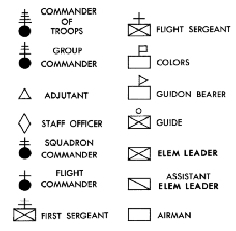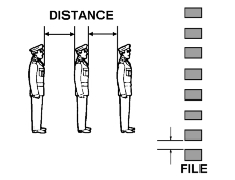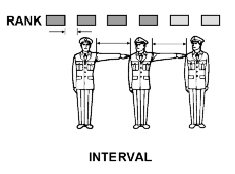|
 Adjutant. A ceremonial position occupied by the junior member of the command staff in reviews and parades andresponsible to the troop or group commander. The adjutant's cadence is 140 steps per minute. Adjutant. A ceremonial position occupied by the junior member of the command staff in reviews and parades andresponsible to the troop or group commander. The adjutant's cadence is 140 steps per minute.
Alignment. Dress or cover.
Base. The element on which a movement is planned, regulated, or aligned.
Cadence. The uniform step and rhythm in marching; that is, the number of steps marched per minute.
Center. The middle point of a formation. On an odd-numbered front, the center is the center person or element. On an even-numbered front, the center is the right center person or element.
Cover. Individuals aligning themselves directly behind the person to their immediate front while maintaining proper distance.
Depth. The total space from front to rear of any formation. An individual's depth is considered to be 12 inches.
Distance. The space from front to rear between units. The distance between individuals in formation is 40 inches as  measured from their chests to the backs of individuals directly in front of them. Flight commanders, guides, and others whose positions in formation are 40 inches from a rank are themselves considered a rank. measured from their chests to the backs of individuals directly in front of them. Flight commanders, guides, and others whose positions in formation are 40 inches from a rank are themselves considered a rank.
Double Time. The rate of marching at 180 steps (30 inches in length) per minute.
Dress. Alignment of elements side by side or in line maintaining proper interval.
Element. The basic formation; that is, the smallest drill unit comprised of at least 3, but usually 8 to 12 individuals, one of whom is designated the element leader.
File. A single column of persons placed one behind the other
Final Line. The line on which the adjutant forms the front rank of troops for a parade or review.
Flank. The extreme right or left (troops right or left) side of a formation in line or in column.
Flight. At least two, but not more than four, elements.
Formation. An arrangement of units.
Front. The space occupied by a unit, measured from flank to flank. The front of an individual is considered to be 22 inches.
Guide. The airman designated to regulate the direction and rate of march.
Head. The leading unit of a column.
In Column. The arrangement of units side by side with guide and element leaders to the head.
In Line. The arrangement of units one behind the other with the guide and element leader to the extreme right flank.
Interval. The space between individuals placed side by side. A normal interval is an arms length. A close interval is 4 inches.
Inverted Column. The arrangement of units side by side with guide and element leaders to the rear.
Inverted Line. The arrangement of units one behind the other with the guide and element leaders to the extreme left flank.
Line of March. A line followed by troops as they pass in review.
Mark Time. Marching in place at a rate of 100 to 120 steps per minute.
Mass Formation. The formation of a squadron or group in which the component units are in column, abreast of each other, and at close interval.
Pace. A step of 24 inches. This is the length of a full step in quick time.
Post. The correct place for an officer, noncommissioned officer (NCO), or airman to stand while in formation.
Quick Time. The rate of marching at 100 to 120 steps (12 or 24 inches in length) per minute.
Rank. A single line of persons placed side by side.
Ready Line. A forming line 20 paces to the rear of the final line where troops are formed for a parade or review at an established time prior to Adjutant's Call.
Reviewing Officer. The senior officer participating in a parade or review.
Slow Time. The rate of marching at 60 steps per minute (used in funeral ceremonies).
Step. The distance measured from heel to heel between the feet of an individual marching.
Unit. Any portion of a given formation.
|